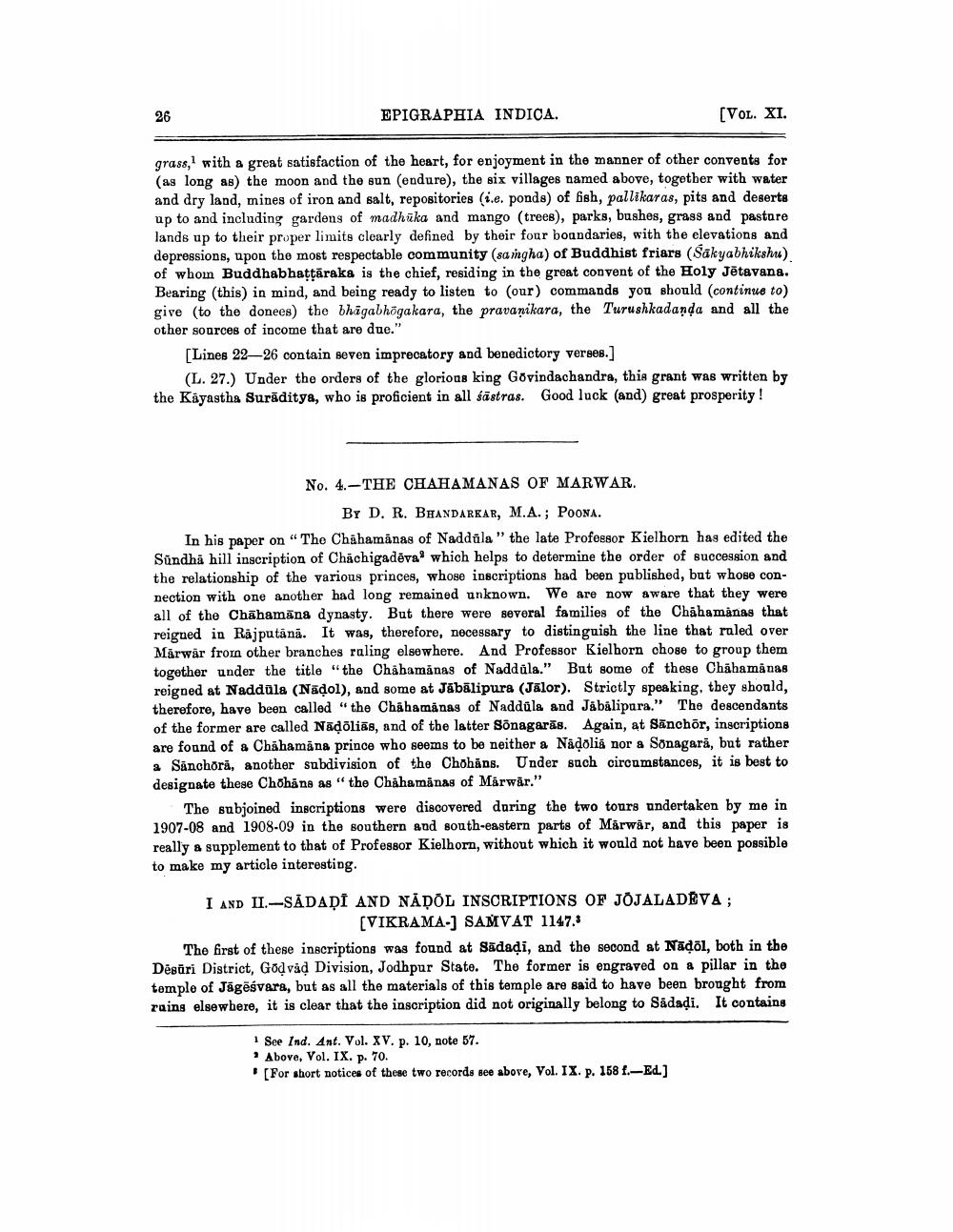________________
26
EPIGRAPHIA INDICA.
[VOL. XI.
grass, with a great satisfaction of the heart, for enjoyment in the manner of other convents for (as long as) the moon and the sun (endure), the six villages named above, together with water and dry land, mines of iron and salt, repositories (i.e. ponds) of fish, pallikaras, pits and deserts up to and including gardens of madhuka and mango (trees), parks, bushes, grass and pasture lands up to their proper limits clearly defined by their four boundaries, with the elevations and depressions, upon the most respectable community (samgha) of Buddhist friars (Sakyabhikshu) of whom Buddhabhaṭṭaraka is the chief, residing in the great convent of the Holy Jētavana. Bearing (this) in mind, and being ready to listen to (our) commands you should (continue to) give (to the donees) the bhagabhögakara, the pravanikara, the Turushkadanda and all the other sources of income that are due."
[Lines 22-26 contain seven imprecatory and benedictory verses.]
(L. 27.) Under the orders of the glorious king Govindachandra, this grant was written by the Kayastha Suraditya, who is proficient in all sastras. Good luck (and) great prosperity!
No. 4.-THE CHAHAMANAS OF MARWAR.
BY D. R. BHANDARKAR, M.A.; POONA.
In his paper on "The Chahamänas of Naddula" the late Professor Kielhorn has edited the Sundhä hill inscription of Chachigadeva which helps to determine the order of succession and the relationship of the various princes, whose inscriptions had been published, but whose connection with one another had long remained unknown. We are now aware that they were all of the Chahamana dynasty. But there were several families of the Chahamanas that reigned in Rajputana. It was, therefore, necessary to distinguish the line that ruled over Marwar from other branches ruling elsewhere. And Professor Kielhorn chose to group them together under the title "the Chahamanas of Naddula." But some of these Chahamanas reigned at Naddüla (Naḍol), and some at Jabalipura (Jalor). Strictly speaking, they should, therefore, have been called "the Chahamanas of Naddüla and Jabalipura." The descendants of the former are called Naḍōlias, and of the latter Sõnagaras. Again, at Sanchor, inscriptions are found of a Chahamana prince who seems to be neither a Naḍolia nor a Sonagară, but rather a Sanchōra, another subdivision of the Chohans. Under such circumstances, it is best to designate these Chohans as "the Chahamänas of Marwar."
The subjoined inscriptions were discovered during the two tours undertaken by me in 1907-08 and 1908-09 in the southern and south-eastern parts of Marwar, and this paper is really a supplement to that of Professor Kielhorn, without which it would not have been possible to make my article interesting.
I AND II.-SĀDAȚI AND NADOL INSCRIPTIONS OF JOJALADĒVA ; [VIKRAMA-] SAMVAT 1147.3
The first of these inscriptions was found at Sadaḍi, and the second at Nadol, both in the Dēsāri District, Godvad Division, Jodhpur State. The former is engraved on a pillar in the temple of Jagesvara, but as all the materials of this temple are said to have been brought from rains elsewhere, it is clear that the inscription did not originally belong to Sadaḍi. It contains
1 See Ind. Ant. Vol. XV. p. 10, note 57.
Above, Vol. IX. p. 70.
[For short notices of these two records see above, Vol. IX. p. 158 f.-Ed.]




